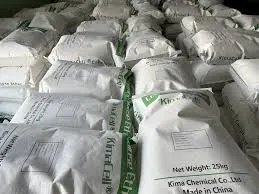
Dec . 11, 2024 09:30 Back to list
Comparing HPMC and HEC for Enhanced Performance in Various Applications
HPMC vs. HEC A Comparative Analysis of Two Popular Hydrocolloids
Hydrocolloids play a crucial role in various industrial applications, ranging from food production to pharmaceuticals. Among these, Hydroxypropyl Methylcellulose (HPMC) and Hydroxyethyl Cellulose (HEC) are two prominent cellulose derivatives frequently used as thickening, gelling, and stabilizing agents. Although they share some similarities, they differ significantly in chemical structure, properties, and applications. This article explores the distinctions between HPMC and HEC, highlighting their unique advantages and suitability for different uses.
Chemical Structure and Properties
HPMC is derived from cellulose through etherification, where hydroxypropyl groups are introduced along with methoxy groups. The presence of these groups enhances its solubility in both cold and hot water, making it an efficient thickener and binder. HPMC is non-ionic and does not gel upon cooling; instead, it forms a transparent, viscous solution that is stable over a wide pH range. Its unique properties allow it to form films, which contribute to its role as a thickening agent in various formulations.
In contrast, HEC is produced by the etherification of cellulose with ethylene oxide, resulting in a compound that is soluble in cold water but can become less viscous at elevated temperatures. HEC is also non-ionic but does not provide the same film-forming abilities as HPMC. However, it is valued for its ability to improve the texture and viscosity of aqueous systems and is particularly beneficial in formulations needing stability against high shear.
Applications
Both HPMC and HEC find applications across a variety of industries, but their specific functionalities make them suitable for different applications.
hpmc vs hec

1. Food Industry In the food sector, HPMC is predominantly used as a thickener, stabilizer, and emulsifier. It helps improve the texture of sauces, dressings, and dairy products, while also acting as a fat replacer in reduced-calorie formulations. HEC, on the other hand, is used in products that require a smooth mouthfeel and improved shelf life, such as salad dressings and sauces.
2. Pharmaceuticals In pharmaceuticals, HPMC is commonly used as an excipient in tablet formulations, serving as a binder and disintegrant. Its film-forming properties also make it suitable for coating tablets, providing a controlled release of active ingredients. HEC is often employed in topical formulations due to its excellent emulsifying and thickening qualities, enhancing the stability and absorption of creams and ointments.
3. Cosmetics and Personal Care HPMC is widely utilized in cosmetic formulations such as lotions, creams, and gels, where its ability to create a smooth texture and enhance skin feel is highly beneficial. HEC, with its thickening ability, is also used in shampoos and conditioners, providing improved viscosity and stability to the products.
Key Differences and Conclusion
The primary differences between HPMC and HEC lie in their solubility, viscosity properties, and applications. HPMC offers enhanced film-forming capabilities and efficacy across varying temperatures, while HEC excels in formulations requiring stability against shear. The choice between HPMC and HEC depends largely on the desired characteristics of the final product and the specific requirements of the formulation.
In conclusion, both HPMC and HEC are integral hydrocolloids in their respective fields. Their distinct properties make them suitable for different applications, allowing manufacturers to choose the best option based on the functional needs of their products. Understanding these differences not only guides formulators in their decisions but also underscores the versatility and importance of cellulose derivatives in modern industry.
-
Versatile Hpmc Uses in Different Industries
NewsJun.19,2025
-
Redispersible Powder's Role in Enhancing Durability of Construction Products
NewsJun.19,2025
-
Hydroxyethyl Cellulose Applications Driving Green Industrial Processes
NewsJun.19,2025
-
Exploring Different Redispersible Polymer Powder
NewsJun.19,2025
-
Choosing the Right Mortar Bonding Agent
NewsJun.19,2025
-
Applications and Significance of China Hpmc in Modern Industries
NewsJun.19,2025







